|
|
|
Sort Order |
|
|
|
Items / Page
|
|
|
|
|
|
|
| Srl | Item |
| 1 |
ID:
178357
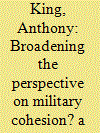

|
|
|
|
|
| Summary/Abstract |
In 2018, Ilmari Käihkö published a special collection in Armed Forces & Society on the debate about small unit cohesion. Later, in reaction to a response by Guy Siebold, he published a further intervention with Peter Haldén. Focusing on my 2006 article in the journal and my subsequent debate, Käihkö has claimed that the cohesion debate is too narrow. It ignores organizational factors in the armed forces and wider political factors, including nationalism and state policy. Consequently, it is incapable of analyzing non-Western state or irregular forces and is only relevant for the 20th and 21st centuries. This response shows that while Käihkö’s extension of the empirical archive to non-Western armed groups is to be welcomed, none of his theoretical claims are sustainable.
|
|
|
|
|
|
|
|
|
|
|
|
|
|
|
|
| 2 |
ID:
180834


|
|
|
|
|
| Summary/Abstract |
Following the death of George Floyd in Minneapolis on 25 May 2020, anti-racist protests occurred across America and Europe. As a result, public institutions in the UK have begun to re-examine their cultures and practices to ensure not only that they are non-discriminatory, but also that they are actively anti-racist. The Army will not be immune to this process. Indeed, senior commanders including the Chief of the Defence Staff have already embraced the ‘decolonizing’ programme. Since 2000, the Army has incorporated significant numbers of Black, Asian and minority ethnic (BAME) soldiers; just over 10 per cent of the Army is now BAME. This article examines the integration of minority soldiers over the last two decades in order to assess the prospects of ‘de-colonization’ in the Army today. Despite the apparent success of the Army's integration policy, this article identifies three obstacles which still obstruct minority integration and are likely to impede de-colonization. Firstly, the majority of the Army's BAME soldiers are not British citizens, but foreign and Commonwealth nationals. Secondly, the young age of the majority of British soldiers generates interactional dynamics in barracks and training which often accidentally excludes foreign minority soldiers. Thirdly, the military ideal of the British Army remains understandably Anglo-Saxon. This article considers the tensions inherent in the Army's multicultural project and lays out suggestions about how they might be overcome to pursue a de-colonizing agenda.
|
|
|
|
|
|
|
|
|
|
|
|
|
|
|
|
| 3 |
ID:
154958
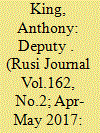

|
|
|
|
|
| Summary/Abstract |
The British Army has traditionally been sceptical about the role of deputy commanders. However, on recent operations, deputy commanders have played an increasingly important executive role. In this article, Anthony King examines why they have become more important and analyses the deep cultural reasons that explain why – even today – the British Army has been slow to embrace the concept of the deputy commander.
|
|
|
|
|
|
|
|
|
|
|
|
|
|
|
|
| 4 |
ID:
133552
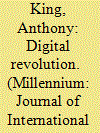

|
|
|
|
|
| Publication |
2014.
|
| Summary/Abstract |
It has been widely acknowledged that military uniforms are significant not only in terms of their practical utility but in terms of their symbolic function. If this is the case, then it is surely noteworthy that in the last ten years there has been a revolution in military uniforms. The disruptive patterns which were the global norm among all military forces in the late twentieth century are in the process of being replaced by new digital patterns. Drawing on the sociology of science and technology, this article explores the development of these uniforms to argue that while neither the scientific research behind digital patterns nor their possible superiority over disruptive designs can be denied, the development of these patterns cannot be seen in purely instrumental or technical terms. Status considerations have been equally important. The paper explores the way in which these new uniforms communicate the new status which professional western forces in the early twenty-first century have been trying to project.
|
|
|
|
|
|
|
|
|
|
|
|
|
|
|
|
| 5 |
ID:
062632


|
|
|
| 6 |
ID:
146254


|
|
|
|
|
| Summary/Abstract |
Although it is widely assumed that successful polities require strong leaders, something like the opposite is probably the case. A successful political system may well be one that has no need of strong leaders and may even eschew them. Strong leaders may occasionally be desirable in any polity, but those occasions are–or should be–rare. As often as not (possibly more often than not) strong leaders pose substantial risks. They are liable to do as much damage as good, possibly more. There is a lot to be said for any polity's political culture and institutions having built into them a fair amount of “leader proofing.”
|
|
|
|
|
|
|
|
|
|
|
|
|
|
|
|
| 7 |
ID:
103298


|
|
|
|
|
| Publication |
2011.
|
| Summary/Abstract |
On 11 September 2010, the United States commemorated the ninth anniversary of the 9/11 attacks. In those nine years, British forces have been engaged in military operations of unexpected location, intensity, scale and duration. While the performance of British troops has been repeatedly praised on these operations, there has been growing disquiet among commentators and, indeed, among the military establishment itself about the conduct of these campaigns. Specifically, the issue of British military command has come under increasing scrutiny. This article examines command frictions at the strategic and operational levels and seeks to provide a sociological explanation of these difficulties. It claims that British commanders have failed to identify a coherent strategy over the past decade while in-theatre operational command has often been characterized by an ad hoc-ery, incoherence and inconsistency. The article suggests that a 'laissez faire' command culture has been evident at strategic and operational levels. While individual mistakes may not be irrelevant, the article explores the way in which this command culture may be a product of institutional pressures within defence and, above all, a product of inter-service rivalry. However, the laissez faire system of command in the armed forces may also be a reflection of much deeper cultural presumptions and preferences within British professional society itself which has always had a strong tendency towards pragmatism, decentralization and shorttermism. The article concludes by offering some suggestions as to how military command might be reformed in light of its potentially profound cultural origins.
|
|
|
|
|
|
|
|
|
|
|
|
|
|
|
|
| 8 |
ID:
152821


|
|
|
|
|
| Summary/Abstract |
Since 2001, Western troops have been heavily engaged in combat in Iraq and Afghanistan raising once again the long-standing question of why small groups of soldiers are willing and able to fight together. Drawing on evidence from recent campaigns, and specifically focusing on American and British forces, this paper examines why small Western units have generally been effective in combat. Against the primary group thesis, originally proposed by Morris Janowitz and Edward Shils in 1948, the article claims that training and battle drills, not interpersonal relations, are the primary factor in generating performance on the battlefield. Moreover, high levels of training alters the relations between soldiers, giving rise to a core group which generates distinctive patterns of motivation.
|
|
|
|
|
|
|
|
|
|
|
|
|
|
|
|
| 9 |
ID:
177812
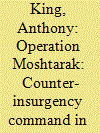

|
|
|
|
|
| Summary/Abstract |
There has been much controversy about the effectiveness of military command in Iraq and Afghanistan. Contributing to these debates, this article examines the changing character of twenty-first century command through the example of Operation Moshtarak. Mostharak was a major operation conducted to secure Kandahar City in 2009–10 by Combined Joint Task Force-6, commanded by Major-General Nick Carter, that acted as the International Security Assistance Force’s Regional Command (South) in this period. The paper explores Carter’s distinctive decision-making method during this campaign to argue that Carter exemplifies a more collective method of command than typically adopted in the twentieth century.
|
|
|
|
|
|
|
|
|
|
|
|
|
|
|
|
| 10 |
ID:
100644


|
|
|
|
|
| Publication |
2010.
|
| Summary/Abstract |
Based on close observation of Regional Command (South) personnel in and around Kandahar, Anthony King offers an early assessment of Hamkari, a counter-insurgency approach that prioritises the political. But does the West really understand the complexities of the tribal fabric of patronage that underpins Afghan society? ISAF must find a way to engage with the power-brokers, or risk ploughing resources and lives into an impossible vision of a centralised state.
|
|
|
|
|
|
|
|
|
|
|
|
|
|
|
|
| 11 |
ID:
075720


|
|
|
| 12 |
ID:
095063
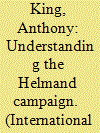

|
|
|
|
|
| Publication |
2010.
|
| Summary/Abstract |
British forces are now engaged in a major operation in southern Afghanistan, the outcome of which is likely to be strategically decisive-especially for the configuration and status of Britain's land forces. Although progress seems to have been made, there has been much criticism of the campaign. Through an analysis of the three-year Helmand mission (Operation Herrick), this article explores whether, for all the improvements in the campaign in terms of resources and numbers of troops, the basic structure of the campaign established in 2006 has endured. Instead of focusing on an 'ink-spot' from which to expand, British forces have tended to operate from dispersed forward operating bases from which they have insufficient combat power to dominate terrain and secure the population. They are consequently engaged in a seemingly endless round of high-intensity tactical battles which are normally successful in themselves but do not contribute to the overarching security of the province. The analysis explores the way in which this distinctive campaign lay-down-the preference for dispersal and high-intensity fighting-may be a reflection of British military culture and its military doctrine. By highlighting potential unacknowledged aspects of the British military profession, the article aims to contribute to debates about the development of the armed forces.
|
|
|
|
|
|
|
|
|
|
|
|
|
|
|
|
| 13 |
ID:
184966


|
|
|
|
|
| Summary/Abstract |
In the last two decades, urban insurgencies have become a major concern for scholars and practitioners. It is widely assumed that because half the human population now live in cities in often appalling conditions, it is inevitable that conflict has migrated to cities, not least because urban areas offer would-be insurgents the best opportunity to evade state security forces and their advanced technologies. Demography and asymmetry have been all but universally accepted in the literature as the sole causes of urban insurgency. They are certainly important. Yet, scholars have overlooked a third vital factor: the size of state forces. In the twentieth century, urban insurgencies were common. However, because states commanded very large military forces at that time, insurgents found it very difficult to operate in urban areas. By contrast, as their forces have contracted in the twenty-first century, states have been unable to dominate urban areas, as they typically did in the twentieth century. Consequently, urban enclaves have appeared inside cities from which insurgents have mounted their attacks and contested with state forces.
|
|
|
|
|
|
|
|
|
|
|
|
|
|
|
|
| 14 |
ID:
193057


|
|
|
|
|
| Summary/Abstract |
On October 7, 2001, 3 weeks after 9/11, U.S. forces attacked Afghanistan; bombers struck Taliban headquarters and Al Qaeda training sites. By early December, the Taliban and Al Qaeda have been defeated and had fled. However, a war that began so successfully in 2001, eventually ended ignominiously on August 30, 2021, almost exactly 20 years later, with a U.S. withdrawal and a total Taliban victory. The speed of the Taliban’s triumph shocked everyone. The entire campaign, costing US$2.3 trillion and 2,488 U.S. lives, had failed—utterly. The United States had lost its longest-ever war. How is it possible to explain a defeat of that magnitude? This article seeks to address this question. Although numerous factors played a role, this article identifies three principal factors: the environment, the local politics, and the Taliban. Afghanistan is a very difficult place to conduct large-scale military operations. The West never came to terms with the local politics and consequently undermined their own efforts. Finally, although they were not militarily sophisticated, the Taliban were politically astute and very resilient.
|
|
|
|
|
|
|
|
|
|
|
|
|
|
|
|
| 15 |
ID:
186085


|
|
|
|
|
| Summary/Abstract |
Conflict has urbanized because half the human population now lives in cities that offer insurgents the best protection from advanced weaponry. However, to understand the increased chance of inter-state urban warfare, it is necessary to consider a third factor: the reduction of force size. As a result of downsizing, state forces are no longer large enough to form fronts, as they did in the twentieth century. Consequently, even in inter-state wars, forces are also likely to converge on urban areas where the most important strategic, operational, and tactical objectives are located.
|
|
|
|
|
|
|
|
|
|
|
|
|
|
|
|
| 16 |
ID:
122227
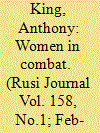

|
|
|
|
|
| Publication |
2013.
|
| Summary/Abstract |
The US secretary of defense announced in January 2013 that, from 2016, women will be allowed to serve in ground-combat roles in the US armed forces. The UK is likely to soon be faced with the need to make a similarly historic decision, having answered key questions such as what is actually known so far about the integration of women into combat units, and its potential impact on cohesion. Anthony King provides a fascinating comparison of the experiences of several Western armed forces, and concludes that in today's world of professional armies, it is not gender that determines cohesion, but training and competence.
|
|
|
|
|
|
|
|
|
|
|
|
|
|
|
|
|
|
|
|
|